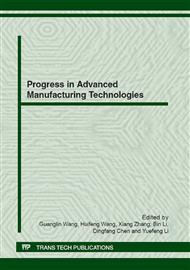p.183
p.187
p.192
p.197
p.201
p.206
p.210
p.217
p.221
FEM Analysis of Temperature in High Speed Cutting of TiAl6V4 Alloys
Abstract:
mprovements in modeling and simulation of metal cutting processes are required in advanced manufacturing technologies. A three dimensional fully thermal mechanical coupled finite element model had been applied to simulate and analyze the cutting temperature for high speed milling of TiAl6V4 titanium alloy. The temperature distribution induced in the tool and the workpiece was predicted. The effects of the milling speed and radial depth of cut on the maximum cutting temperature in the tool was investigated. The results show that only a rising of temperature in the lamella of the machined surface is influenced by the milling heat. The maximum temperature in the tool increases with increasing radial depth of cut and milling speed which value is 310°C at a speed of 60 m/min and increases to 740°C at 400m/min. The maximum temperature is only effective on a concentrated area at the cutting edge and the location of the maximum temperature moves away from the tool tip for higher radial depths of milling. The predicted temperature distribution during the cutting process is consistent with the experimental results given in the literature. The results obtained from this study provide a fundamental understanding the process mechanics of HSM of TiAl6V4 titanium alloys.
Info:
Periodical:
Pages:
201-205
Citation:
Online since:
August 2012
Authors:
Price:
Сopyright:
© 2012 Trans Tech Publications Ltd. All Rights Reserved
Share:
Citation:


